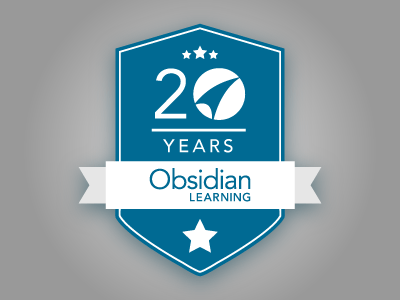Last week I attended the Association for the Advancement of Computing in Education (AACE) E-Learn 2016 conference in Washington, D.C. My colleague Shannon Hart and I were there to present our paper on blanded learning (Victor & Hart, 2016), which is based on the white paper Obsidian published earlier this year, with the addition of case study of a solution we developed for one of our clients.
Because AACE’s focus is educational technology in K-12 and higher education, the tone of its conferences is much more academic than those Obsidian usually attends. When we go to a conference like DevLearn or ATD TechKnowledge, we’re there to learn about the latest trends in technology-enhanced learning, discuss best practices in design and development, network with colleagues, and (let’s be honest) promote our company’s products and services. At a conference like E-Learn we do those things too – but we’re not there primarily to promote the company. And, for me at least, it’s a refreshing change to be among colleagues who also are simply there to learn and share, with no other agenda (of course, many people who attend commercial conferences are also there just to learn from each other and take best practices back to their colleagues).
So, besides presenting our paper, why did we decide to go to E-Learn 2016? At Obsidian we ground our work in the research on how people learn and how best to teach. We want our work not only to look good but to provide effective, engaging learning experiences. An e-learning course that’s only text doesn’t look very nice, but is that a reason not to present a course with no graphics? It is a reason (and a very good one), but empirical research from cognitive psychologists like Allen Paivio or Richard Mayer can take us deeper, showing us how graphics not only enhance the aesthetics of our courses but also measurably improve comprehension and retention. This, for a learning geek like me, makes attending a conference like E-Learn worthwhile.
At any conference I attend, I always set some kind of personal learning goal, such as getting up to date on best practices for mobile learning development, finding out what’s new in Captivate, or learning about how people are integrating social networking tools in their courses. Because I’m currently writing a white paper on video in learning, my goal at E-Learn 2016 was to learn more about using video and other visual tools to enhance learning.
Every conference has one or more keynotes, people who (usually) are great speakers and bring fresh insight into some aspect of our industry. Keynote speakers might be CLOs or entrepreneurs or pioneers in technology (or they might be actors or politicians, presumably there for a bit of edutainment to get us through the day). At E-Learn 2016, one of the keynotes was Richard Mayer himself, who provided an overview of the evidence-based principles of his Cognitive Theory of Multimedia Learning (CTML).
We’ll have more to say on CTML when we publish our learning video white paper, but suffice it for now to say that through many empirical studies over the years, Mayer has demonstrated that we learn better through words and pictures than through words alone. As I tweeted during the session, it really was a master class on best practices for developing web-based training. Here are a few other conference highlights:
Using video for observational learning
Many classes require observation of proper technique. Joanna Grymes and her colleagues from Arkansas State University described the issues they faced when converting an early childhood education course to online format. As part of their licensing requirements, students are required to directly observe children in a classroom setting – but how can this be done in an online course? One of my key takeaways from this session: curated video collections (on sites like YouTube or Vimeo) can be used to provide observational experiences to learners. However, as Grymes noted, the Department of Education and other U.S. government agencies require videos (and all media elements) to have text-based equivalents for Section 508 accessibility compliance. In the case of videos, this means transcripts. If you use a video someone else created, you can’t easily provide a transcript, so you might need to look into transcription software.
Using technology to overcome cultural barriers
There are no vendor exhibitions at E-Learn 2016. The closest thing to an exhibition is the poster sessions, in which researchers share (on a small scale) their current research. One that particularly caught my eye was by a group of Japanese researchers on a technological solution to a culturally-defined educational issue. K-16 education in Japan typically occurs in large classrooms in lecture format, with learners passively listening to the teachers’ instruction (Hoda, Susono, & Shinomura, 2016). However, educators are attempting to make learning more active, and to accomplish this students must learn presentation skills. One technique for helping students prepare is a “3s Card,” which simply contains spaces for writing a title and three points for presenting and discussing a topic in small groups. Shotaro Hoda (clad for the evening in a karate suit) has developed a cross-platform app that lets students create 3s cards and share them with their class. An elegant solution for a challenging cultural issue.
Tracking informal learning with video
We’ve written before about informal learning in the workplace. But informal learning can be difficult to track. Kevin Oliver of North Carolina State University presented a solution implemented with his doctoral student Rob Moore in which students in an online course used Voicethread to provide instructor and peer support in the development of makerspace projects (Oliver & Moore, 2016). Voicethread allows users to capture their own activities (in this case, the design of simple scientific experiments) and thought processes and to interact with each other using text and media elements, including video. Using the tool, learners were able to solicit input and provide feedback on each other’s designs - something that is frequently done in “maker” projects but that is difficult in an asynchronous online setting. The result for the learners was a “natural style of documentation” of their own (and others’) informal learning processes.
Teaching with Twitter
Within a case study of a course to prepare ASL interpreters to pass a national interpreting test, Rikki McCormick Lowe provided suggestions for using Twitter to facilitate learning “without the boundaries of space and time” (Lowe, 2016). Twitter, she suggested, can provide immediate communication (using text, graphics, video, and other multimedia) among instructors and learners. One of the more striking (to me) of Lowe’s suggestions was that the public nature of Twitter encourages increased attention to detail (everyone can read what you write), exposes learners to multiple points of view, and models good digital citizenship. With public figures (including politicians) using Twitter to influence opinion, this was a most timely observation.
So, will Obsidian go to more conferences like E-Learn 2016? I hope so, because it’s important to stay grounded in the science and to learn from the people who do the research that supports the evidence-based work we do.
References
Hoda, S., Susono, H., & Shinomura, T. (2016). Web 3s card for reflection and sharing. In Proceedings of E-Learn: World Conference on E-Learning in Corporate, Government, Healthcare, and Higher Education 2016 (pp. 166-170). Chesapeake, VA: Association for the Advancement of Computing in Education (AACE).
Lowe, R. (2016). Twitter as a tool to promote curricular change. In Proceedings of E-Learn: World Conference on E-Learning in Corporate, Government, Healthcare, and Higher Education 2016 (pp. 1048-1053). Chesapeake, VA: Association for the Advancement of Computing in Education (AACE).
Oliver, K. & Moore, R. (2016). Supporting documentation of informal learning and making from a distance with Voicethread. In Proceedings of E-Learn: World Conference on E-Learning in Corporate, Government, Healthcare, and Higher Education 2016 (pp. 836-840). Chesapeake, VA: Association for the Advancement of Computing in Education (AACE).
Victor, S. & Hart, S. (2016). Blended learning: A flexible learning and development model. In Proceedings of E-Learn: World Conference on E-Learning in Corporate, Government, Healthcare, and Higher Education 2016 (pp. 275-284). Chesapeake, VA: Association for the Advancement of Computing in Education (AACE).







